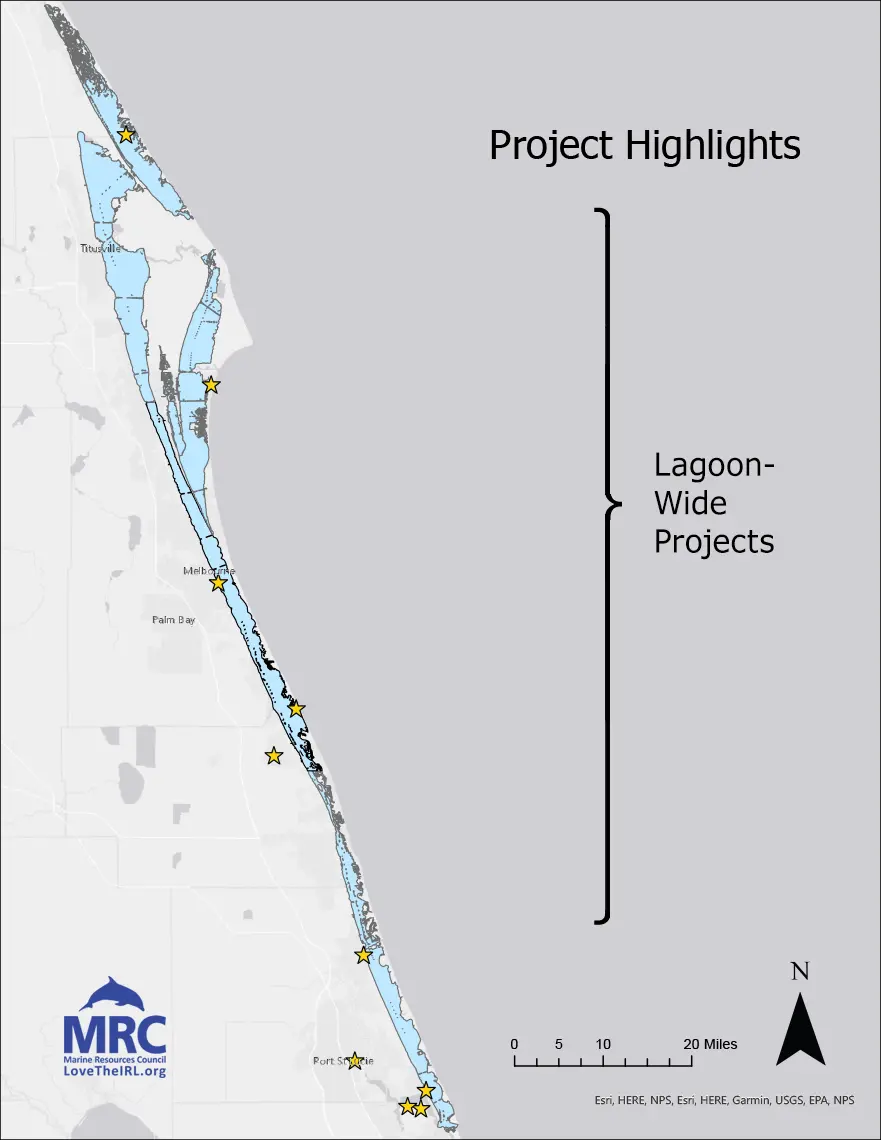Projects
Big problems take big solutions and a lot of collaboration. Numerous nonprofit organizations and government agencies are working on restoration and research projects up and down the Indian River Lagoon. We invited organizations from around the region to report on their 2024 Lagoon projects. Hover over map ‘hotspots’ (blue dots) to learn more about each project and the organization behind it.
You can also find comprehensive IRL project maps on Save Our Indian River Lagoon (SOIRL) and One Lagoon websites.
The Project Highlights map is best viewed on a desktop or laptop.
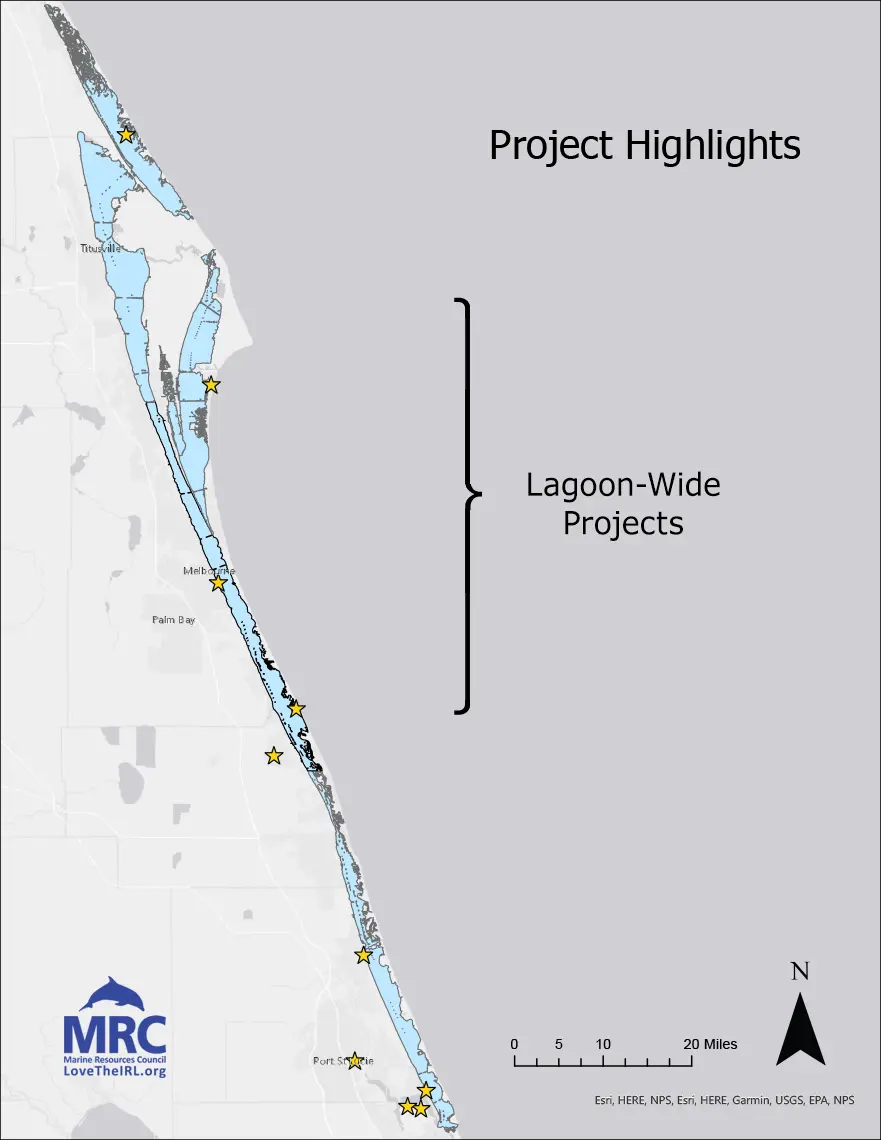

Project Details
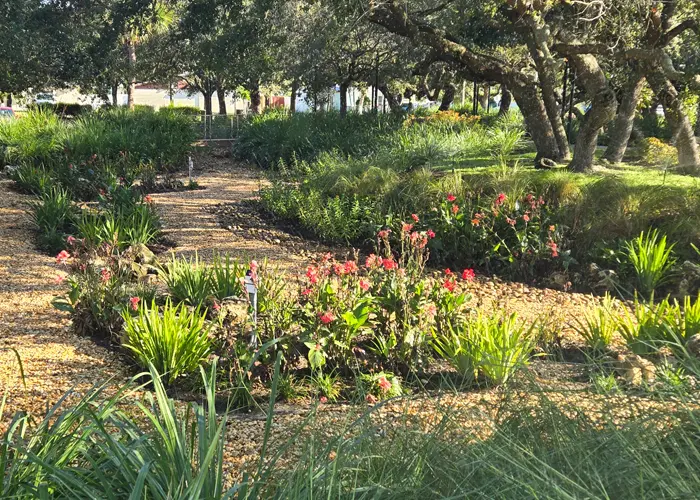
Veterans Memorial Park “Smart” Rain Garden
| Address: | 265 Polk Ave, Cape Canaveral, FL 32920 |
| Organizations: | City of Cape Canaveral, Stetson University’s Institute for Water and Environmental Resilience, Kimley-Horn Associates, Marine Resources Council, Brevard Zoo, St. Johns River Water Management District, Ferguson Waterworks, Riverside Conservancy, Florida Sea Grant/UF/IFAS, East Central Florida Regional Planning Council, Indian River Lagoon National Estuary Program, National Science Foundation (funding source) Florida Atlantic University, Embry-Riddle Aeronautical University, and the Florida Institute of Technology. |
| Project Description: | Nutrient pollution reduction, local biodiversity enhancement, and flood mitigation. |
| URL: | cityofcapecanaveral.org |
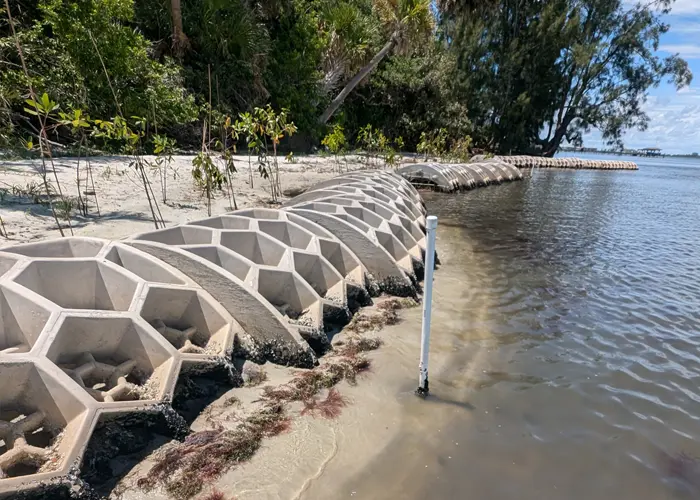
Ais Lookout Point North Living Shoreline Restoration
| Address: | 3275 Dixie Hwy NE, Palm Bay, FL 32909 |
| Organizations: | Brevard County Tourism Development Council, MRC, Reef Arches |
| Project Description: | An experimental hybrid living shoreline was installed in March of 2024 to stop the erosion of a bluff at Ais Lookout Point Park and protect a historical Ais shell midden. The site is divided into several testing units to allow MRC and FIT scientists to observe the effectiveness of concrete breakwaters (Reef Arches) and mangroves in restoration activities. The breakwaters act to slow incoming wave energy, promote beach re-growth, and prevent the habitat fragmentation effects often associated with seawalls and other methods of shoreline hardening. Over 120 red mangroves from MRC’s nursery were also planted in July of 2024 to help trap and hold the eroding beach, provide wildlife habitat, and filter nutrients and pollutants from entering the IRL. |
| URL: | lovetheirl.org |
Atmospheric Deposition Monitoring Stations: Sebastian Inlet State Park
| Organizations: | IRLNEP, WSP USA Environment & Infrastructure Inc., St. Johns River Water Management District, Indian River County Environmental Health Department, Florida Atlantic University-Harbor Branch |
| Project Description: | Project continues operations for monitoring meteorological conditions, dry and wet atmospheric deposition of total phosphorus (TP) and total nitrogen (TN) from three monitoring stations, located at Canaveral National Seashore, Sebastian Inlet State Park and Indian Riverside Park in Martin County. The project is vital to better-understand the role of atmospheric deposition in the IRL’s nutrient budget. It is estimated that atmospheric deposition approaches 50% of non-point sources of nitrogen entering the IRL annually. |
| URL: | onelagoon.org |
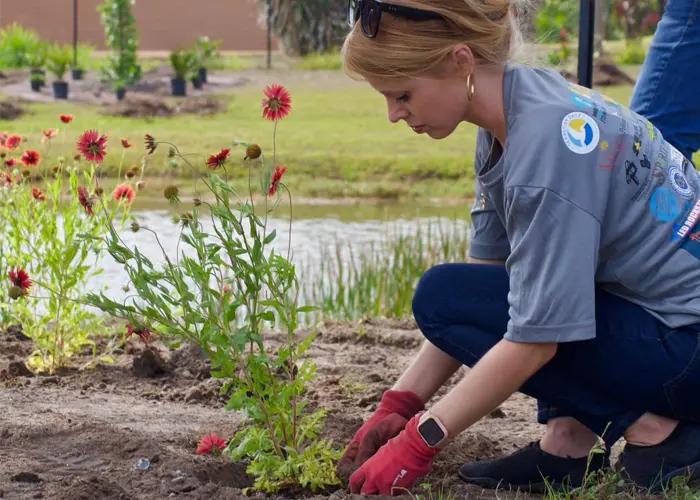
Tulip Pond Project
| Address: | 690 Tulip Drive, Sebastian, FL 32958 |
| Organizations: | IRLNEP, City of Sebastian, IRC UF/IFAS Extension |
| Project Description: | The purpose of the project was to simultaneously beautify and enhance the functioning of the stormwater pond on Tulip Drive. The pond was developed in 2016 to improve stormwater drainage in the immediate area and it remained sodded since then, with the occasional new plant species settling in. Through this project, the addition of plants and an aerating fountain during the Tulip Pond Project were installed to add some life and vibrancy to the pond’s aesthetics, but also function to prevent the buildup of muck and detritus and help filter excess nutrients out of the stormwater conveyance system. |
| URL: | cityofsebastian.org |
Protecting the Indian River Lagoon and Reducing Nutrient Loads Caused by Septic Systems and Aging Wastewater Infrastructure
| Address: | Fort Pierce, FL |
| Organizations: | IRLNEP, Fort Pierce Utilities Authority |
| Project Description: | This project aims to improve the overall environmental health of the community by eliminating 850 lbs. of nitrogen/year from reaching the Indian River Lagoon. It consists of eliminating 50 septic systems throughout FPUA’s wastewater service territory. Additionally, FPUA will enhance its wastewater infrastructure by lining 4.23 miles of wastewater pipes with Cured-in-Place PVC lining. This PVC lining will rectify the problems caused by untreated sewage leaking into the soil and groundwater flows to the IRL, caused by cracks in the aging, vitrified clay pipes. |
| URL: | onelagoon.org |
Septic to Sewer Conversion to Reduce Nitrogen Pollution Along the Monterrey Waterway
| Address: | City of Port St. Lucie |
| Organizations: | IRLNEP, City of Port St. Lucie, Florida Atlantic University- Harbor Branch |
| Project Description: | The North Fork of the St. Lucie Estuary has experienced degraded water quality leading to recurring closures of the water body for recreational use. To determine the sources of this impairment, the City of Port St. Lucie contracted with Harbor Branch Oceanographic Institute-Florida Atlantic University to conduct a microbial source tracking study. That study confirmed elevated fecal coliform levels. The greatest concentrations consistently occurred in five dense urbanized areas of the City, including along the Monterrey Waterway which directly drains into the North Fork of the St. Lucie River. Older septic tanks near the Monterrey Waterway are believed to be contributing to this pollution. |
| URL: | onelagoon.org |
Atmospheric Deposition Monitoring Stations: Indian Riverside Park
| Organizations: | IRLNEP, WSP USA Environment & Infrastructure Inc., St. Johns River Water Management District, Indian River County Environmental Health Department, Florida Atlantic University-Harbor Branch Oceanographic Institute |
| Project Description: | Project continues operations for monitoring meteorological conditions, dry and wet atmospheric deposition of total phosphorus (TP) and total nitrogen (TN) from three monitoring stations, located at Canaveral National Seashore, Sebastian Inlet State Park and Indian Riverside Park in Martin County. The project is vital to better-understand the role of atmospheric deposition in the IRL’s nutrient budget. It is estimated that atmospheric deposition approaches 50% of non-point sources of nitrogen entering the IRL annually. |
| URL: | onelagoon.org |
SE Illinois Avenue Living Shoreline Project
| Address: | SE Illinois Ave, Stuart, FL |
| Organizations: | IRLNEP, City of Stuart |
| Project Description: | A living shoreline will be installed to prevent erosion and provide habitat for marine species and wading birds. Plantings will provide nutrient removal from the existing stormwater discharge entering the IRL at this location. A buffered shoreline will be constructed at the north end of SE Illinois Avenue to provide filtration for stormwater runoff from the northern portion of the SE Illinois Avenue right-of-way and adjacent properties. The project is important for the City to continue progress towards resiliency and meeting BMAP requirements for the St. Lucie River. The conceptual design of this project is complete, and the project is underway. The IRL Council has previously awarded $85,000 for this project. This project seeks an additional $90,000 to address increases in construction costs for equipment, materials, and labor. |
| URL: | onelagoon.org |
Reduction of TN and TP Using Floating Treatment Wetlands
| Address: | 2401 SE Monterey Road, Stuart, FL 34996 |
| Organizations: | IRLNEP, Martin County |
| Project Description: | This project seeks to reduce nutrient loading into the St. Lucie Estuary and greater IRL by replacing existing dilapidated floating treatment wetlands within two stormwater treatment areas with new floating treatment wetlands of an improved design. A total of 12 floating treatment wetlands will be installed within the Golden Gate and Old Palm City STAs, comprising a total of 6,280 ft² of surface area. The improved design will yield a significant savings in maintenance costs from $4.00/ft² to $1.40/ft² (52%). It will also increase the expected lifespan of floating treatment wetlands from 4-6 years to 8-10 years. |
| URL: | onelagoon.org |
Suffocating Sand: Mapping Hypoxia and its Impacts on Benthic Nutrient Fluxes in the IRL, Phase II
| Organizations: | IRLNEP, FIT, Brevard County Department of Natural Resources, Brevard Zoo, City of Cocoa Beach, City of Satellite Beach |
| Project Description: | Hypoxia and hydrogen sulfide impact nutrient cycling, loss of ecosystem services, eutrophication, plus virtually all restoration activities, yet, few data are available to quantify the extent of IRL hypoxia or the distribution of sediment sulfide. Phase 1 of this project identified widespread hypoxia in bottom water and raised questions about the distribution of sediment sulfide, which in other estuaries has been linked to large-scale losses of seagrasses, mortality of benthic fauna and inhibited nitrogen removal. Using a relatively low-cost network of continuous monitoring stations we will track the extent, duration and movement of bottom water dissolved oxygen (DO) adding measurements of sediment sulfide. Impacts of variable DO and sediment sulfide on nutrient fluxes will be determined using benthic flux chambers located as sites where DO and sulfide monitoring are carried out. |
| URL: | onelagoon.org |
Optimizing Syringodium filiforme (manatee grass) Production Factors in a Subtropical Seagrass Nursery for Restoration Applications
| Organizations: | IRLNEP, Florida Oceanographic Society, University of Florida |
| Project Description: | There are limited resources detailing methods to grow S. filiforme in a nursery setting and few available sources of the plant outside of harvesting declining natural beds. To increase the availability of S. filiforme for use in restoration activities, multiple planting methods will be tested in nursery based mesocosm studies. The first part of the study will compare survival and growth of planting units after plant division in different substrates (coarse vs. fine sand). The second part of the study will test the effects of fertilizers (Osmocote, a common fertilizer, and struvite, a wastewater derived fertilizer) to determine the effects of nutrient addition on S. filiforme development. This work will culminate in a planting guide which will form the foundation for nursery propagation of S. filiforme in the future. |
| URL: | onelagoon.org |
Building Lagoon-Wide Capacity for Seagrass Recovery Through Infrastructure Investments
| Organizations: | IRLNEP, Sea and Shoreline, LLC; Florida Atlantic University-Harbor Branch; Florida Oceanographic Society; Brevard Zoo; Marine Discovery Center |
| Project Description: | This is year 3 of a 5-year commitment to build capacity among the IRL seagrass restoration community of practice through 5 years of recurring investments in infrastructure, equipment and personnel for land-based or in-lagoon seagrass nurseries that can support expanded plant cultivation for large-scale restoration projects as well as support the associated research needed to better understand seagrass ecophysiology and cultivation. |
| URL: | onelagoon.org |
Using Genetic Tools to Boost Seagrass Restoration Success in the Indian River Lagoon
| Organizations: | IRLNEP, Mote Marine Laboratory, UF, FOS, FAU- Harbor Branch |
| Project Description: | Seagrass restoration in the IRL relies on donor material from seagrass nurseries. However, these nurseries lack information on the current genetics of their stock. In 2018, genetic analysis of the Florida Oceanographic Society seagrass nursery revealed unexpectedly low diversity, and we hypothesize that consistently favorable nursery conditions may lead to competitive exclusion, thereby reducing diversity and subsequent resilience. We will investigate the current genetic diversity of multiple nurseries and test methods for maintaining diversity in nurseries. This project will analyze the genetic diversity of seagrass donor material, the genetic diversity of natural seagrass meadows in the IRL, and novel tools for improving seagrass restoration success. |
| URL: | onelagoon.org |
Harmful Algal Bloom (HAB) Monitoring
| Organizations: | IRLNEP, UF, FAU-Harbor Branch |
| Project Description: | Funding supports continuing IRL algae and cyanobacteria monitoring by UF, which monitors 5 northern and central IRL locations, and FAU-Harbor Branch, which monitors 5 southern locations. Monitoring is performed every 2 weeks. Collecting data on phytoplankton composition, abundance, biovolume, biomass, identification of HAB species and ambient water quality parameters is performed during each sampling. When HABs are detected, relevant state agencies and the IRLNEP are notified, species are identified to the lowest taxon possible and quantified. |
| URL: | onelagoon.org |
Indian River Lagoon Biodiversity Inventory
| Organizations: | IRLNEP, Smithsonian Marine Station—Fort Pierce |
| Project Description: | Project continues the update, continuing reorganization and refinement of information housed in the web-based Indian River Lagoon Species Inventory, developed by the Smithsonian Marine Station in partnership with the IRLNEP since 2000. Funding will expand the website’s capabilities to make use of new techniques in identifying and curating collections; maintain and expand the Species Inventory database; improve its functionality; and communicate its availability as a learning tool to students, resource managers and the academic community. |
| URL: | irlspecies.org |
SOIRL Projects
| Organization: | Save Our Indian River Lagoon |
| URL: | brevardfl.gov/SaveOurLagoon |
Your Financial Support Makes It Happen!
Donate to become an Annual Member Today!
Marine Resources Council (MRC) coordinates Lagoon-wide efforts to Save the Indian River Lagoon, but we need your support to succeed. It will take a community to save the Lagoon, working at all levels.
MRC is holding government workshops, coordinating diverse stakeholder groups, showcasing community leaders, and working with businesses and individuals to encourage actions that will help save the Indian River Lagoon.
This website is managed by the Marine Resources Council, a 501(c)(3) nonprofit organization that has been dedicated to protecting and restoring the Indian River Lagoon since 1983.
Marine Resources Council • 3275 Dixie Hwy NE, Palm Bay, FL 32905.
Site development by Editype.


